This article needs additional citations for verification .(October 2017) |
This is a list of factions in the Mexican Revolution .
This article needs additional citations for verification .(October 2017) |
This is a list of factions in the Mexican Revolution .
Revolutionary followers of Venustiano Carranza from 1913 to 1914, and thereafter the Government army from 1914 until his death in 1920. In 1915, an insurgent group known as the Seditionistas was formed and supported by the Carrancistas.
Title first used for all anti-Huerta forces in the north before the 1914 breakaway of Pancho Villa following the defeat of Victoriano Huerta. Venustiano Carranza, the "First Chief" of the Revolution, attracted talented generals to his faction, most especially Álvaro Obregón. Obregón defeated Villa's División del Norte in the Battle of Celaya, ending Villa as a national force. The Constitutionalists were eventually the victorious faction of the Revolution, with Carranza becoming president of Mexico and the Mexican Constitution of 1917, drafted by this winning faction in a constitutional convention at Querétaro, was promulgated.
Joint name for Villistas and Zapatistas as supporters of the Convention of Aguascalientes. Held in October–November 1914, the northern coalition that defeated Huerta in July 1914 attempted to settle the path forward following the victory. Pancho Villa dominated the convention, but Alvaro Obregón also played a role. Villa had split from Carranza following Huerta's defeat, while Obregón remained loyal to First Chief Venustiano Carranza. Those supporting Villa marginalized Carranza's role. Emiliano Zapata and Villa pledged support for each other's armies, but it was in principle only, not in practice. Eulalio Gutiérrez was elected president of Mexico by the convention. Carranza and Obregón retreated to Veracruz. The Conventionists briefly held practically all Mexican territory, but the central authority was weak and could not hold the advantage against the smaller Constitutionalist faction. Obregón decisively defeated Villa in a series of battles the summer of 1915, ending the Conventionists as a force.
Term used for all Government troops from Mexican independence in 1821 to 1914, but usually associated particularly with Victoriano Huerta's Federal Army. (Huerta was president from February 1913 to July 1914). The Federal Army was disbanded in August 1914 following Huerta's resignation and exile.
See also Rurales for national mounted police force forming part of the Federal forces under Diaz and Huerta.
Adherents of Brig. General Felix Diaz, nephew of former president Porfirio Díaz, who opposed both the Madero and Carranza governments in rebellions between 1913 and 1920. He led the reactionary conservative National Reorganizer Army in ineffective revolts late in the Revolution.
Supporters of Victoriano Huerta, dictator of Mexico from February 1913 to July 1914.
Name given to various revolutionary armies fighting under the umbrella leadership of Francisco I. Madero in 1910–11, during the first part of the war. Maderistas in the postrevolutionary phase of Mexican history sought to keep alive the memory of Madero, who was martyred during the February 1913 Ten Tragic Days.
The military wing of the Partido Liberal Mexicano (PLM) under the leadership of the Flores-Magon brothers, who organised abortive local uprisings against Diaz in 1906 and 1908, and fomented further revolts after 1911, particularly in Baja California. A force of Magonistas was led by the Welsh soldier of fortune General Carol Ap Rhys Pryce, the "Gringo Revolutionary" .
Followers of Pascual Orozco, also known as the Colorados ("Red Flaggers"). They fought first for Madero, 1910–11, and revolted against his government in 1912 under the Plan Orozquista, before joining the Huerta army in February 1913. Contemporary newspaper reports on the Mexican Revolution referred to Colorados as the "irregulars" of the Federal Army. [1]
Supporters of long-time Mexican dictator Porfirio Díaz. The Porfiristas were generally conservative, experienced bureaucrats (popularly known as cientificos or scientists) and soldiers of the Diaz regime. After the fall of Diaz, many Porfiristas made intrigues with Reyistas, Huertistas, and Felicistas.
Supporters of long time military man and politician General Bernardo Reyes. Reyes and Reyistas participated in the plotting of the coup to overthrow Madero in La decena trágica of February 1913, in which both Madero and Reyes were killed. The Reyistas had major support from America in the forms of arms and ammunition supplied by the El Paso Reyista Junta, headed by a Rafael Limón Molina. [2]
Followers of Francisco "Pancho" Villa, mainly serving in the División del Norte (Northern Division). Formed part of the Maderista forces, and later fought in opposition to the Huerta and Carranza governments, the Villistas later formed a spatially isolated alliance with the Zapatistas, who remained in Morelos. Villa's men were mostly made up of vaquero and charro caudillos, rancheros , shopkeepers, miners, migrant farm workers, unemployed workers, railway workers, and Maderista bureaucrats, who seized haciendas and fought for an undefined socialism. [3] Adolfo Gilly wrote that Villismo, though fighting for land redistribution and justice, did not challenge capitalist relations as previously set down during the Porfirio era, but was merely an outgrowth of the bourgeois state-oriented revolution of Madero. [4]
Followers of Emiliano Zapata, based in Morelos state from 1911 until his death in 1919. They fought for Madero until Zapata became disillusioned with his policies, and thereafter in opposition to all Mexican governments until their leader's death in 1919. The Zapatistas fought for radical land redistribution and political autonomy, and rallied behind the anarchist demand, ¡Tierra y Libertad!.
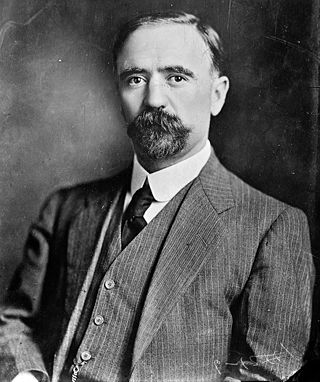
Francisco I. Madero González was a Mexican businessman, revolutionary, writer and statesman, who served as the 37th president of Mexico from 1911 until he was deposed in a coup d'état in February 1913 and assassinated. He came to prominence as an advocate for democracy and as an opponent of President and de facto dictator Porfirio Díaz. After Díaz claimed to have won the fraudulent election of 1910 despite promising a return to democracy, Madero started the Mexican Revolution to oust Díaz. The Mexican revolution would continue until 1920, well after Madero and Díaz's deaths, with hundreds of thousands dead.
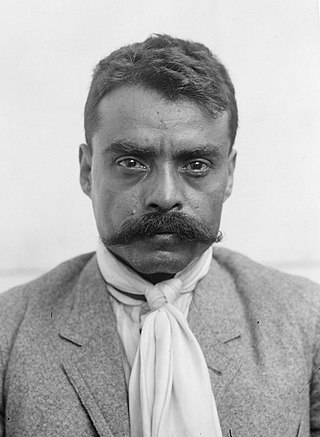
Emiliano Zapata Salazar was a Mexican revolutionary. He was a leading figure in the Mexican Revolution of 1910–1920, the main leader of the people's revolution in the Mexican state of Morelos, and the inspiration of the agrarian movement called Zapatismo.

Francisco "Pancho" Villa was a Mexican revolutionary and general in the Mexican Revolution. He was a key figure in the revolutionary movement that forced out President Porfirio Díaz and brought Francisco I. Madero to power in 1911. When Madero was ousted by a coup led by General Victoriano Huerta in February 1913, Villa joined the anti-Huerta forces in the Constitutionalist Army led by Venustiano Carranza. After the defeat and exile of Huerta in July 1914, Villa broke with Carranza. Villa dominated the meeting of revolutionary generals that excluded Carranza and helped create a coalition government. Emiliano Zapata and Villa became formal allies in this period. Like Zapata, Villa was strongly in favor of land reform, but did not implement it when he had power. At the height of his power and popularity in late 1914 and early 1915, the U.S. considered recognizing Villa as Mexico's legitimate authority.
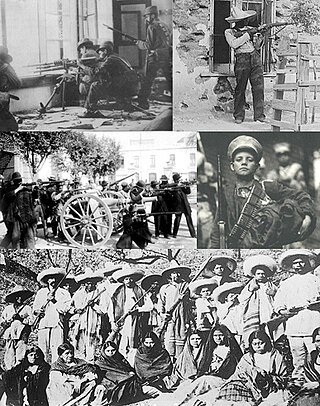
The Mexican Revolution was an extended sequence of armed regional conflicts in Mexico from 20 November 1910 to 1 December 1920. It has been called "the defining event of modern Mexican history" and resulted in the destruction of the Federal Army, its replacement by a revolutionary army, and the transformation of Mexican culture and government. The northern Constitutionalist faction prevailed on the battlefield and drafted the present-day Constitution of Mexico, which aimed to create a strong central government. Revolutionary generals held power from 1920 to 1940. The revolutionary conflict was primarily a civil war, but foreign powers, having important economic and strategic interests in Mexico, figured in the outcome of Mexico's power struggles; the U.S. involvement was particularly high. The conflict led to the deaths of around one million people, mostly noncombatants.
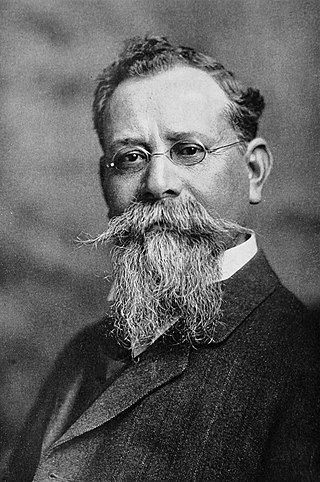
José Venustiano Carranza de la Garza was a Mexican land owner and politician who served as President of Mexico from 1917 until his assassination in 1920, during the Mexican Revolution. He was previously Mexico's de facto head of state as Primer Jefe of the Constitutionalist faction from 1914 to 1917, and previously served as a senator and governor for Coahuila. He played the leading role in drafting the Constitution of 1917 and maintained Mexican neutrality in World War I.

Álvaro Obregón Salido was a Mexican military general and politician who served as the 46th President of Mexico from 1920 to 1924. Obregón was re-elected to the presidency in 1928 but was assassinated before he could take office.
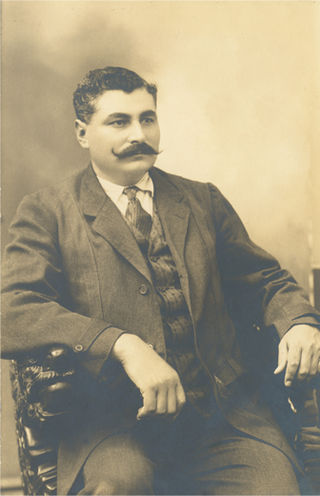
Eulalio Gutiérrez Ortiz was a general in the Mexican Revolution from state of Coahuila. He is most notable for his election as provisional president of Mexico during the Aguascalientes Convention and led the country for a few months between 6 November 1914 and 16 January 1915. The Convention was convened by revolutionaries who had successfully ousted the regime of Victoriano Huerta after more than a year of conflict. Gutiérrez rather than "First Chief" Venustiano Carranza was chosen president of Mexico and a new round of violence broke out as revolutionary factions previously united turned against each other. "The high point of Gutiérrez's career occurred when he moved with the Conventionist army to shoulder the responsibilities of his new office [of president]." Gutiérrez's government was weak and he could not control the two main generals of the Army of the Convention, Pancho Villa and Emiliano Zapata. Gutiérrez moved the capital of his government from Mexico City to San Luis Potosí. He resigned as president and made peace with Carranza. He went into exile in the United States, but later returned to Mexico. He died in 1939, outliving many other major figures of the Mexican Revolution.

The Plan of Ayala was a document drafted by revolutionary leader Emiliano Zapata during the Mexican Revolution. In it, Zapata denounced President Francisco Madero for his perceived betrayal of the revolutionary ideals embodied in Madero's Plan de San Luis Potosí, and set out his vision of land reform. The Plan was first proclaimed on November 28, 1911, in the town of Ayala, Morelos, and was later amended on June 19, 1914. The Plan of Ayala was a key document during the revolution and influenced land reform in Mexico during the 1920s and 1930s. It was the fundamental text of the Zapatistas.

The Liberation Army of the South was a guerrilla force led for most of its existence by Emiliano Zapata that took part in the Mexican Revolution from 1911 to 1920. During that time, the Zapatistas fought against the national governments of Porfirio Díaz, Francisco Madero, Victoriano Huerta, and Venustiano Carranza. Their goal was rural land reform, specifically reclaiming communal lands stolen by hacendados in the period before the revolution. Although rarely active outside their base in Morelos, they allied with Pancho Villa to support the Conventionists against the Carrancistas. After Villa's defeat, the Zapatistas remained in open rebellion. It was only after Zapata's 1919 assassination and the overthrow of the Carranza government that Zapata's successor, Gildardo Magaña, negotiated peace with President Álvaro Obregón.

The Constitutional Army, also known as the Constitutionalist Army, was the army that fought against the Federal Army, and later, against the Villistas and Zapatistas during the Mexican Revolution. It was formed in March 1913 by Venustiano Carranza, so-called "First-Chief" of the army, as a response to the murder of President Francisco I. Madero and Vice President José María Pino Suárez by Victoriano Huerta during La Decena Trágica of 1913, and the resulting usurpation of presidential power by Huerta.

The Mexican Federal Army, also known as the Federales in popular culture, was the military of Mexico from 1876 to 1914 during the Porfiriato, the long rule of President Porfirio Díaz, and during the presidencies of Francisco I. Madero and Victoriano Huerta. Under President Díaz, a military hero against the French Intervention in Mexico, the Federal Army was composed of senior officers who had served in long ago conflicts. At the time of the outbreak of the Mexican Revolution most were old men and incapable of leading men on the battlefield. When the rebellions broke out against Díaz following fraudulent elections of 1910, the Federal Army was incapable of responding. Although revolutionary fighters helped bring Francisco I. Madero to power, Madero retained the Federal Army rather than the revolutionaries. Madero used the Federal Army to suppress rebellions against his government by Pascual Orozco and Emiliano Zapata. Madero placed General Victoriano Huerta as interim commander of the military during the Ten Tragic Days of February 1913 to defend his government. Huerta changed sides and ousted Madero's government. Rebellions broke out against Huerta's regime. When revolutionary armies succeeded in ousting Huerta in July 1914, the Federal Army ceased to exist as an entity, with the signing of the Teoloyucan Treaties.
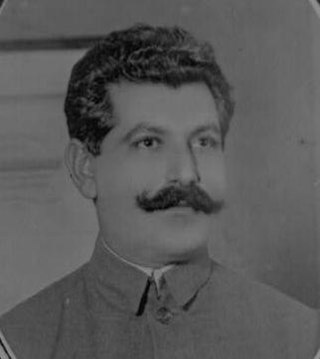
Lucio Blanco was a Mexican military officer and revolutionary, noteworthy for his participation in the Mexican Revolution of 1910 to 1920.
Manuel Peláez Gorrochotegui (1885–1959) Mexican military officer, noteworthy for his participation in the Mexican Revolution of 1910 to 1920.

The Constitutionalists were a faction in the Mexican Revolution (1910–1920). They were formed in 1914 as a response to the assassination of Francisco Madero and Victoriano Huerta's coup d'etat. Also known as Carrancistas, taking that name from their leader, Venustiano Carranza the governor Coahuila. The Constitutionalists played the leading role in defeating the Mexican Federal Army on the battlefield. Carranza, a centrist liberal attracted Mexicans across various political ideologies to the Constitutionalist cause. Constitutionalists consisted of mainly middle-class urbanites, liberals, and intellectuals who desired a democratic constitution under the guidelines "Mexico for Mexicans" and Mexican nationalism. Their support for democracy in Mexico, caught the attention of the United States who aided their cause. In 1914, the United States occupied Mexico's largest port in Veracruz in an attempt to starve Huerta's government of customs revenue. They crafted and enforced the Mexican Constitution of 1917 which remains in force today. Following the defeat of General Huerta, the Constitutionalists outmaneuvered their former revolutionary allies Emiliano Zapata and Pancho Villa becoming the victorious faction of the Mexican Revolution. However the Constitutionalists were divided amongst themselves and Carranza was assassinated in 1920. He was succeeded by General Álvaro Obregón who began enforcing the 1917 constitution and calming revolutionary tensions. His assassination and the subsequent power vacuum this created spurred his successor, Plutarco Elías Calles to create the National Revolutionary Party (PNR) which would hold uninterrupted political power in Mexico until 2000.

Juan Andreu Almazán was a Mexican revolutionary general, politician and businessman. He held high posts in the Mexican Army in the 1920s and ran for the presidency of Mexico in 1940 in a highly disputed election, having accumulated great wealth from construction. General Almazán became one of Mexico's and Latin America’s wealthiest citizens in the early 1940s.
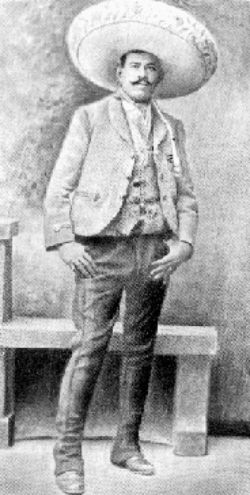
Amador Salazar Jiménez was a Mexican military leader who participated in the Mexican Revolution.

The Convention of Aguascalientes was a major meeting that took place during the Mexican Revolution between the factions in the Mexican Revolution that had defeated Victoriano Huerta's Federal Army and forced his resignation and exile in July 1914.

The Conventionists were a faction led by Pancho Villa and Emiliano Zapata which grew in opposition to the Constitutionalists of Venustiano Carranza and Álvaro Obregón during the Mexican Revolution. It was named for the Convention of Aguascalientes of October to November 1914.

Pablo González Garza was a general during the Mexican Revolution. He is considered to be the main organizer of the assassination of Emiliano Zapata.

The Mexican Border War, or the Border Campaign, was a series of military engagements which took place in the Mexican–American border region of North America during the Mexican Revolution. The period of the war encompassed World War I, and the German Empire attempted to have Mexico attack the United States, as well as engaging in hostilities against American forces there itself.